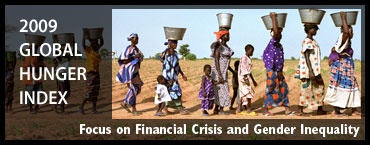Report links hunger, gender inequalities for first time
I had just settled down to breakfast in front of the computer this morning when I got an emailed press release from the International Food Policy Research Institute (IFPRI) with the latest global hunger index. Like any normal person I skipped right past it.
But it’s been a while since I’ve seen anything on global hunger, so, after washing down my bagel with cold, black coffee, I read the email.
As expected, it had good and bad news. The good news is that hunger rates worldwide have shrunk since1990; the bad news is that they have shrunk less than 25 percent despite the greater focus on world hunger by various international organizations as well as the affected nations.
The 2009 Global Hunger Index, for the first time, also shows that high rates of hunger are strongly linked to gender inequalities, especially in terms of literacy and access to education.
The situation is especially serious in Chad, which ranks fifth worst on the Global Hunger Index, second worst in terms of gender inequality, and has a female literacy rate of only 13 percent, compared to 41 percent for men. The report said that IFPRI research shows that equalizing men’s and women’s status would reduce the number of malnourished children by 13.4 million in South Asia and by 1.7 million in Sub-Saharan Africa.
The press statement quoted Agnes Quisumbing, report co-author and IFPRI senior research fellow: “Women’s educational level and status or power relative to men’s in households and communities significantly affect children’s nutrition. In South Asia (especially), women’s low social status and limited access to schooling have dire consequences for the nutrition, health, and wellbeing of both mothers and their children.”
IFPRI Director General Joachim von Braun said, “Knowing that hunger and gender inequality go hand-in-hand, an important step to ending world hunger is empowering women and eradicating gender disparities in education, health, economic participation, and political opportunities.
“After decades of slow progress in the fight against hunger, child malnourishment is now on the rise due to recent economic developments. It is imperative that commitments made at the G20 and other global policy meetings are swiftly transformed into real action in cooperation with developing countries.”
Overall, the report found that 29 countries around the world have “alarming or extremely alarming” levels of hunger, and thirteen countries have actually seen increases in their hunger levels since 1990. The Democratic Republic of Congo scored the worst, followed by Burundi, Eritrea, Sierra Leone, Chad, and Ethiopia.
The situation is also bad in South Asia largely because of widespread child malnutrition. In Bangladesh and India, more than 40 percent of children are underweight. An important exception in the region is Sri Lanka, which has been committed to universal education and reproductive health care, and has been successful at reducing hunger.
Even though there is severe hunger in Afghanistan and Iraq, there wasn’t enough data available to be included in this report.
Most of the progress in the battle against hunger has been made in Southeast Asia and Latin America and the Caribbean.
The Global Hunger Index is being released in advance of World Food Day (October 16) for the fourth year by IFPRI, Welthungerhilfe, and Concern Worldwide. The Index ranks countries on three leading indicators—prevalence of child malnutrition, rates of child mortality, and the proportion of people who are calorie deficient—and combines them into one score.
The IFPRI is one of 15 centers supported by the Consultative Group on International Agricultural Research, an alliance of 64 governments, private foundations, and international and regional organizations.

1 Comment to “Report links hunger, gender inequalities for first time”
RSS feed for comments on this post. TrackBack URI
By Ghanashyam Ojha, October 15, 2009 @ 9:15 pm
Larry, great article. Hunger is still a problem in Nepal as well. However, it’s not as serious as in Bangladesh and India in South Asian region because ours is still agro-based economy. I liked the article.
Keep it up.
Ghanashyam Ojha
Nepal